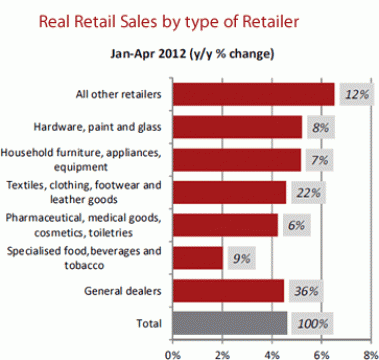Improving retail indicators despite cautious economic outlooks
 Latest retail sales figures show that total real retail sales were up by only 1% year-on-year in April 2012. This was down considerably compared with the the average year-on-year growth of 5,9% that was recorded during the first three months of 2012.
Latest retail sales figures show that total real retail sales were up by only 1% year-on-year in April 2012. This was down considerably compared with the the average year-on-year growth of 5,9% that was recorded during the first three months of 2012.
With real retail sales for the first quarter of 2012 rising by 1% year-on-year, retailers are anticipating a slow-growth year – in line with decreasing economic prospects in both the domestic and global economies.
Nonetheless, expectations are for positive retail growth in 2012 – thanks to key metrics like increasing employment levels, higher real remuneration and lower household debt.
“The forecast is that real retail sales will taper off to 2.7% in the final quarter of this year,” says SA Council of Shopping Centres (SACSC) general manager Amanda Stops.
“Lackluster employment growth, along with the fact that households are trying to boost savings and reduce debt, are all factors in this expectation.”
But, if employment data is what retailers are watching most closely, there are some heartening signs in the indicators.
The first quarter of 2012 saw just 0.1% increase in employment year-on-year, with certain sectors – e.g. wholesale and retail trade, hotels and restaurants – reporting positive growth in jobs.
“It’s a small increase, but an increase nonetheless,” points out Stops.
Another positive sign is that real remuneration remained positive at 3.9% for the first quarter of 2012.
“The expectation is an average growth rate of 3.4% overall for 2012.”
Another good sign is that household debt, although relatively high, is at its lowest level since 2008: 74.7% of disposable income – or almost 75 cents in the rand.
“Households are starting to push back on debt levels and save more, although some forms of credit uptake are still on the rise,” explains Stops, pointing to installment sales credit and loan advances as cases in point.
The lower level of household debt is making consumers less financially vulnerable, with the SACSC’s Consumer Vulnerability Index decreasing by 34% between 2008 and 2012.
Overall, consumers are feeling somewhat neutral about consumer spending, with the FNB/BER consumer confidence index (CCI) remaining unchanged for the first quarter of 2012.
“Perhaps most telling of all, however, is that the CCI shows consumers are much more optimistic about their own financial outlook than for the SA economy in the next 12 months,” concludes Stops.













